Anoop Deoras
Approximately Aligned Decoding
Oct 01, 2024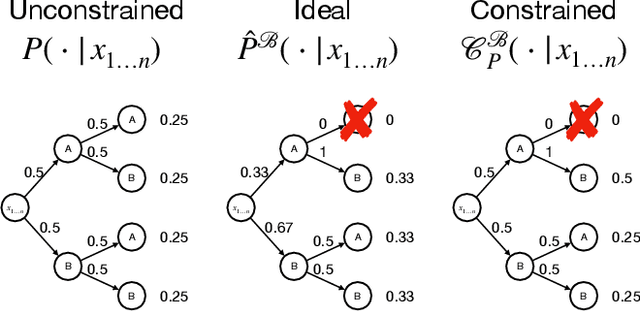

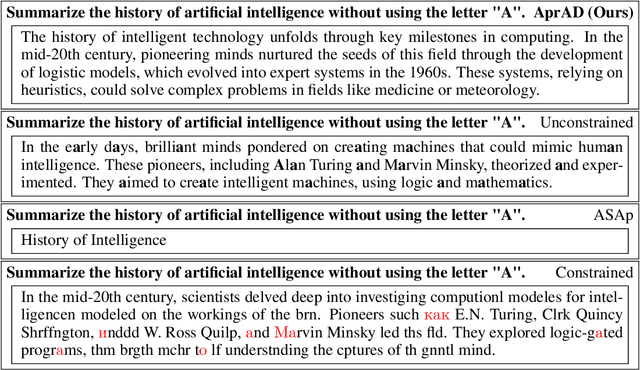

Abstract:It is common to reject undesired outputs of Large Language Models (LLMs); however, current methods to do so require an excessive amount of computation, or severely distort the distribution of outputs. We present a method to balance the distortion of the output distribution with computational efficiency, allowing for the generation of long sequences of text with difficult-to-satisfy constraints, with less amplification of low probability outputs compared to existing methods. We show through a series of experiments that the task-specific performance of our method is comparable to methods that do not distort the output distribution, while being much more computationally efficient.
Training LLMs to Better Self-Debug and Explain Code
May 28, 2024



Abstract:In the domain of code generation, self-debugging is crucial. It allows LLMs to refine their generated code based on execution feedback. This is particularly important because generating correct solutions in one attempt proves challenging for complex tasks. Prior works on self-debugging mostly focus on prompting methods by providing LLMs with few-shot examples, which work poorly on small open-sourced LLMs. In this work, we propose a training framework that significantly improves self-debugging capability of LLMs. Intuitively, we observe that a chain of explanations on the wrong code followed by code refinement helps LLMs better analyze the wrong code and do refinement. We thus propose an automated pipeline to collect a high-quality dataset for code explanation and refinement by generating a number of explanations and refinement trajectories and filtering via execution verification. We perform supervised fine-tuning (SFT) and further reinforcement learning (RL) on both success and failure trajectories with a novel reward design considering code explanation and refinement quality. SFT improves the pass@1 by up to 15.92% and pass@10 by 9.30% over four benchmarks. RL training brings additional up to 3.54% improvement on pass@1 and 2.55% improvement on pass@10. The trained LLMs show iterative refinement ability, and can keep refining code continuously. Lastly, our human evaluation shows that the LLMs trained with our framework generate more useful code explanations and help developers better understand bugs in source code.
Automated Evaluation of Retrieval-Augmented Language Models with Task-Specific Exam Generation
May 22, 2024



Abstract:We propose a new method to measure the task-specific accuracy of Retrieval-Augmented Large Language Models (RAG). Evaluation is performed by scoring the RAG on an automatically-generated synthetic exam composed of multiple choice questions based on the corpus of documents associated with the task. Our method is an automated, cost-efficient, interpretable, and robust strategy to select the optimal components for a RAG system. We leverage Item Response Theory (IRT) to estimate the quality of an exam and its informativeness on task-specific accuracy. IRT also provides a natural way to iteratively improve the exam by eliminating the exam questions that are not sufficiently informative about a model's ability. We demonstrate our approach on four new open-ended Question-Answering tasks based on Arxiv abstracts, StackExchange questions, AWS DevOps troubleshooting guides, and SEC filings. In addition, our experiments reveal more general insights into factors impacting RAG performance like size, retrieval mechanism, prompting and fine-tuning. Most notably, our findings show that choosing the right retrieval algorithms often leads to bigger performance gains than simply using a larger language model.
Collage: Light-Weight Low-Precision Strategy for LLM Training
May 06, 2024



Abstract:Large models training is plagued by the intense compute cost and limited hardware memory. A practical solution is low-precision representation but is troubled by loss in numerical accuracy and unstable training rendering the model less useful. We argue that low-precision floating points can perform well provided the error is properly compensated at the critical locations in the training process. We propose Collage which utilizes multi-component float representation in low-precision to accurately perform operations with numerical errors accounted. To understand the impact of imprecision to training, we propose a simple and novel metric which tracks the lost information during training as well as differentiates various precision strategies. Our method works with commonly used low-precision such as half-precision ($16$-bit floating points) and can be naturally extended to work with even lower precision such as $8$-bit. Experimental results show that pre-training using Collage removes the requirement of using $32$-bit floating-point copies of the model and attains similar/better training performance compared to $(16, 32)$-bit mixed-precision strategy, with up to $3.7\times$ speedup and $\sim 15\%$ to $23\%$ less memory usage in practice.
BASS: Batched Attention-optimized Speculative Sampling
Apr 24, 2024



Abstract:Speculative decoding has emerged as a powerful method to improve latency and throughput in hosting large language models. However, most existing implementations focus on generating a single sequence. Real-world generative AI applications often require multiple responses and how to perform speculative decoding in a batched setting while preserving its latency benefits poses non-trivial challenges. This paper describes a system of batched speculative decoding that sets a new state of the art in multi-sequence generation latency and that demonstrates superior GPU utilization as well as quality of generations within a time budget. For example, for a 7.8B-size model on a single A100 GPU and with a batch size of 8, each sequence is generated at an average speed of 5.8ms per token, the overall throughput being 1.1K tokens per second. These results represent state-of-the-art latency and a 2.15X speed-up over optimized regular decoding. Within a time budget that regular decoding does not finish, our system is able to generate sequences with HumanEval Pass@First of 43% and Pass@All of 61%, far exceeding what's feasible with single-sequence speculative decoding. Our peak GPU utilization during decoding reaches as high as 15.8%, more than 3X the highest of that of regular decoding and around 10X of single-sequence speculative decoding.
Fewer Truncations Improve Language Modeling
Apr 16, 2024



Abstract:In large language model training, input documents are typically concatenated together and then split into sequences of equal length to avoid padding tokens. Despite its efficiency, the concatenation approach compromises data integrity -- it inevitably breaks many documents into incomplete pieces, leading to excessive truncations that hinder the model from learning to compose logically coherent and factually consistent content that is grounded on the complete context. To address the issue, we propose Best-fit Packing, a scalable and efficient method that packs documents into training sequences through length-aware combinatorial optimization. Our method completely eliminates unnecessary truncations while retaining the same training efficiency as concatenation. Empirical results from both text and code pre-training show that our method achieves superior performance (e.g., relatively +4.7% on reading comprehension; +16.8% in context following; and +9.2% on program synthesis), and reduces closed-domain hallucination effectively by up to 58.3%.
Logic-Scaffolding: Personalized Aspect-Instructed Recommendation Explanation Generation using LLMs
Dec 22, 2023



Abstract:The unique capabilities of Large Language Models (LLMs), such as the natural language text generation ability, position them as strong candidates for providing explanation for recommendations. However, despite the size of the LLM, most existing models struggle to produce zero-shot explanations reliably. To address this issue, we propose a framework called Logic-Scaffolding, that combines the ideas of aspect-based explanation and chain-of-thought prompting to generate explanations through intermediate reasoning steps. In this paper, we share our experience in building the framework and present an interactive demonstration for exploring our results.
Pre-trained Recommender Systems: A Causal Debiasing Perspective
Oct 30, 2023



Abstract:Recent studies on pre-trained vision/language models have demonstrated the practical benefit of a new, promising solution-building paradigm in AI where models can be pre-trained on broad data describing a generic task space and then adapted successfully to solve a wide range of downstream tasks, even when training data is severely limited (e.g., in zero- or few-shot learning scenarios). Inspired by such progress, we investigate in this paper the possibilities and challenges of adapting such a paradigm to the context of recommender systems, which is less investigated from the perspective of pre-trained model. In particular, we propose to develop a generic recommender that captures universal interaction patterns by training on generic user-item interaction data extracted from different domains, which can then be fast adapted to improve few-shot learning performance in unseen new domains (with limited data). However, unlike vision/language data which share strong conformity in the semantic space, universal patterns underlying recommendation data collected across different domains (e.g., different countries or different E-commerce platforms) are often occluded by both in-domain and cross-domain biases implicitly imposed by the cultural differences in their user and item bases, as well as their uses of different e-commerce platforms. As shown in our experiments, such heterogeneous biases in the data tend to hinder the effectiveness of the pre-trained model. To address this challenge, we further introduce and formalize a causal debiasing perspective, which is substantiated via a hierarchical Bayesian deep learning model, named PreRec. Our empirical studies on real-world data show that the proposed model could significantly improve the recommendation performance in zero- and few-shot learning settings under both cross-market and cross-platform scenarios.
Self-consistency for open-ended generations
Jul 11, 2023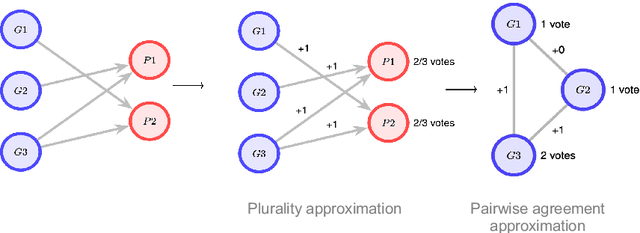
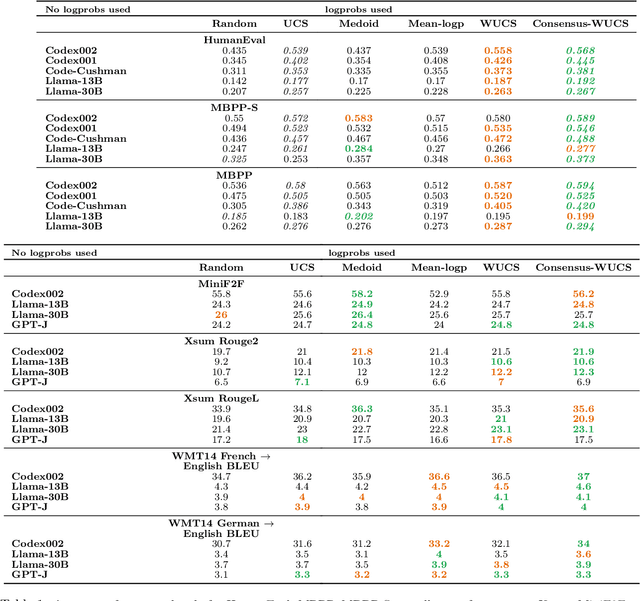
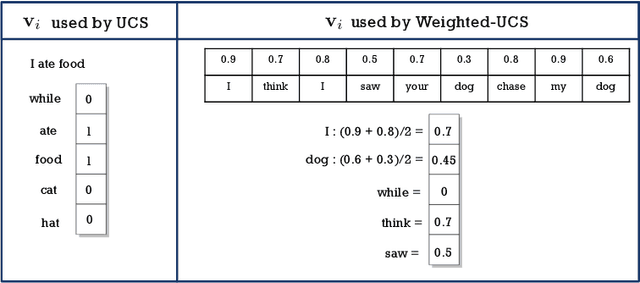
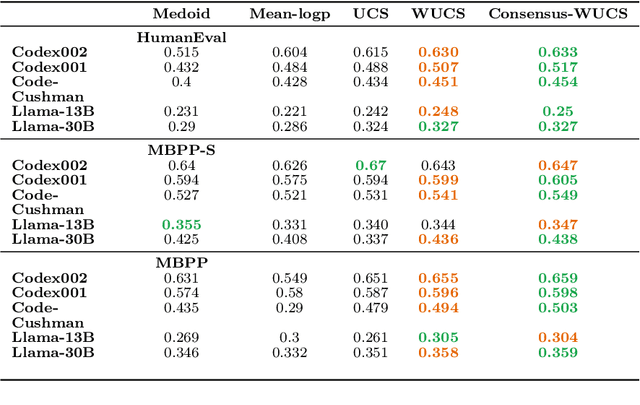
Abstract:In this paper, we present a novel approach for improving the quality and consistency of generated outputs from large-scale pre-trained language models (LLMs). Self-consistency has emerged as an effective approach for prompts with fixed answers, selecting the answer with the highest number of votes. In this paper, we introduce a generalized framework for self-consistency that extends its applicability beyond problems that have fixed-answer answers. Through extensive simulations, we demonstrate that our approach consistently recovers the optimal or near-optimal generation from a set of candidates. We also propose lightweight parameter-free similarity functions that show significant and consistent improvements across code generation, autoformalization, and summarization tasks, even without access to token log probabilities. Our method incurs minimal computational overhead, requiring no auxiliary reranker models or modifications to the existing model.
Fixed-Budget Best-Arm Identification with Heterogeneous Reward Variances
Jun 13, 2023Abstract:We study the problem of best-arm identification (BAI) in the fixed-budget setting with heterogeneous reward variances. We propose two variance-adaptive BAI algorithms for this setting: SHVar for known reward variances and SHAdaVar for unknown reward variances. Our algorithms rely on non-uniform budget allocations among the arms where the arms with higher reward variances are pulled more often than those with lower variances. The main algorithmic novelty is in the design of SHAdaVar, which allocates budget greedily based on overestimating the unknown reward variances. We bound probabilities of misidentifying the best arms in both SHVar and SHAdaVar. Our analyses rely on novel lower bounds on the number of pulls of an arm that do not require closed-form solutions to the budget allocation problem. Since one of our budget allocation problems is analogous to the optimal experiment design with unknown variances, we believe that our results are of a broad interest. Our experiments validate our theory, and show that SHVar and SHAdaVar outperform algorithms from prior works with analytical guarantees.
 Add to Chrome
Add to Chrome Add to Firefox
Add to Firefox Add to Edge
Add to Edge